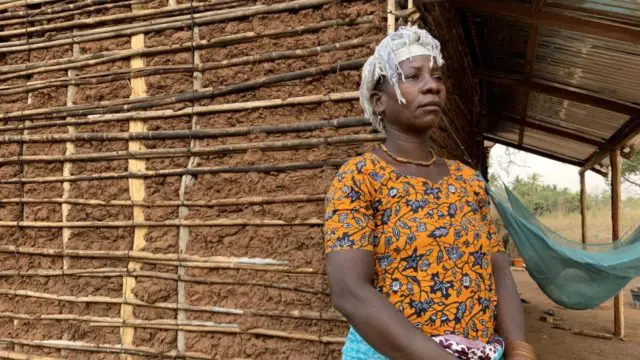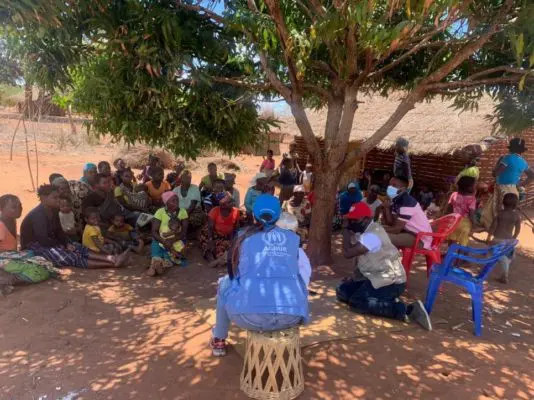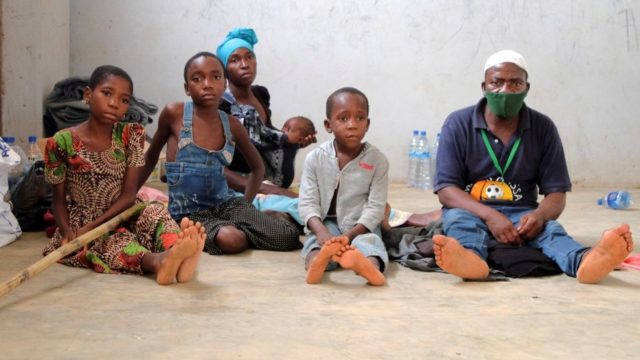With UNHCR’s help, refugees and internally displaced people hit by cyclones are building new homes that can withstand the impacts of climate change.
By Hélène Caux in Corrane and Maratane, Nampula province, Mozambique
“I had never experienced such strong winds and rains in my life!” whispers 56-year-old Patrício Alberto Mponda, recalling the event that still traumatizes him and his family.
On 11 March 2022, Cyclone Gombe made landfall on Mozambique’s coast, before moving inland and blazing a trail of destruction through the provinces of Nampula and Zambezia. Winds reached up 190 kilometres per hour, mowing down swathes of houses, schools, roads, and bridges, and flooding farmlands. Fragile shelters housing displaced people and refugees stood no chance against Gombe’s ferocity.
The roof of Patrício’s home in Corrane site for internally displaced people in Nampula Province blew off and landed in the yard and the mud walls started to crumble and collapse. “My wife Anastasia and our nine children just stared in shock at what was happening,” says Patrício. “Within minutes, we were left out in the open.”
His neighbours offered to shelter them in their home, and they stayed there for a week while they built a temporary shelter.
Many other shelters in Corrane IDP site and Maratane refugee settlement, also in Nampula province, were severely damaged that night.
Mozambique is one of the countries most vulnerable to climate change. In recent years, changing weather patterns have seen extreme weather events such as cyclones, tropical storms, floods and drought become more frequent and intense. In March 2019, Cyclone Idai, struck Mozambique, as well as Malawi and Zimbabwe, followed in April by Cyclone Kenneth. Some 250,000 people were displaced and 650 people killed.
This year, including Tropical Storm Ana and Cyclone Gombe, the country has endured five tropical storms and cyclones. Gombe alone impacted 736,000 people.
In addition to the devastating impact of climate disasters, Mozambique is confronted by a major conflict waged by non-state armed groups in its northern Cabo Delgado province which has now spread to neighbouring provinces, including Nampula. The violence has displaced close to 1 million people since 2017.
Patrício’s village in Cabo Delgado was attacked three times by armed groups. “The two first times, we fled to the bush and retuned to our homes after they had looted everything,” he says.
During the second attack in April 2020, Patrício’s 22-year-old nephew was shot dead and his 24-year-old daughter was kidnapped. Since her abduction, he has had no news of her whereabouts or wellbeing.
“During the third attack in July 2020, they burned 70 houses, including mine, and beheaded some people. We had no choice but to flee for our lives. We ended up here in Corrane.”
The succession of disastrous events has taken a toll on Patrício’s mental health and wellbeing. Recently however, he and his wife have helped to build a new, stronger house for their family as part of a project supported by UNHCR, the UN Refugee Agency, and its partner Caritas.
The project actively involves displaced people in the design, construction and reinforcement of their new homes against climatic extremes. They prepare the mud used for the walls and often assist workers in completing the roof. The approach gives them a sense of ownership and the skills to rebuild or repair any damage in the future.
“We created a shelter with overhanging roofs around it to be able to withstand gale-force winds,” says UNHCR shelter officer Armando Macave. “We also improved the structure of the shelter itself.”
He explains that the new houses are built with locally-sourced wood and bamboo, reinforced with ropes recycled from old tires, and zinc sheets for the roofs. So far, around 300 of the new shelters have been built at Corrane with plans to build a further 250 by the end of the year. More funding and support is needed to be able to construct additional shelters for displaced people affected by extreme weather.
In the coming months, a similar approach will be used to build new homes for refugees and the surrounding host community in Maratane. The settlement, which hosts some 9,300 refugees, mainly from the Democratic Republic of the Congo and Burundi, was also devastated by Cyclone Gombe with 80 per cent of shelters damaged, and some completely destroyed. Thousands of people from the local community were also affected.
“It was really tragic,” says 35-year-old Burundian refugee Dorotea Ndahisenga. “In a matter of minutes, we did not have a home anymore. The roof collapsed just after I had taken my seven children outside to safety. It was like escaping a conflict. The children were crying; I felt very lonely and powerless. My husband left me earlier this year and there was no one I could rely on.”
Dorotea and her children found short-term refuge at a neighbour’s house and then in an unoccupied shelter, but they hope to move into a new house the camp’s church is helping to build.
“I don’t know what our future is.”
Despite such help, every day is a struggle for Dorotea. “I cultivate potatoes on a small plot of land owned by a Mozambican. My crops were destroyed when Gombe hit but I cleaned the devastation away and re-planted. Now I have potatoes again.”
Dorotea sells her produce to other refugees and uses the income to buy other food, but it is still not enough. “I’m alone with seven children and I don’t know what our future is. Hopefully, we can move soon to our new house where we will feel at home.”
The climate crisis has amplified the vulnerability of refugees and displaced people like Patrício and Dorotea who were already struggling to find food, shelter, security and work. In spite of this, they are determined to be prepared the next time disaster strikes.
“I am so happy to be able to move to a new house soon, and I’m also very satisfied with the whole process of having helped build it,” says Patrício. “When I compare the previous shelter with this one, the new shelter is much better. I know I will feel safer in this home, should there be new cyclones or tropical storms. What I need now is a piece of land to cultivate my own food and be independent.”
Originally published by UNHCR on 10 November 2022.





